THE MOST SCENIC DISASTER
Post-Katrina cinema pours out of New Orleans.
by DEREK JENKINS
http://www.oxfordamericanmag.com/content.cfm?ArticleID=393&Entry=Extras
New Orleans has always been among the most photogenic of places. A beauty on par with Paris, New York, and the country of India, the city's strange allure goes beyond wrought iron, hanging moss, and the wet sheen given to a lively palette by that muggy climate. But whereas New York had Woody Allen, India Jean Renoir and Satyajit Ray, and Paris the Poetic Realists of the thirties (as well as the what-have-yous of every decade since), pre-Katrina New Orleans maintained a cinematic mystery only occasionally penetrated by cameras. That is, until Les Blank and his crack team of ethnographic documentarians lifted the curtain. Beginning with his work on Easy Rider and on through Always for Pleasure and J’ai été au bal, Blank captured the color and sound of New Orleans like none before and revealed a secret truth about New Orleans that opened the cinematic floodgates. The city has a face with no bad side, a visage that's mystifying from all angles.
Give that face a black eye, an urgent fragility, a tragedy on the scale of Katrina—the pull only grows stronger. Filmmakers from across the country drew a bead on the most scenic disaster to hit our shores, and the result is a cinema of anger and indictment and senselessness but also beauty and humanity and even hope. Spike Lee, in a heroic feat equal to those of impromptu WWII documentarians like John Ford and Frank Capra, released his epic When the Levees Broke just under a year after the hurricane made landfall. It's Emergency Cinema, a First-Response Film. I daresay no other filmmaker could have accomplished the same depth and scope in so short a time, and also that Lee's never made a more important film. Three years later and at their own mortal pace, other filmmakers, working in both fiction and nonfiction formats, have likewise trained their talents on the aftermath of Katrina.
Countless motion pictures bob in the wake of this disaster, but future generations will likely find in the seven astonishing films featured here the most complete and useful records of that same harrowing story.
............
GLORY AT SEA
Glory at Sea departs radically from the everyday. Director Benh Zeitlin's apocalyptic and lyrical tale of rebirth after the flood, the film begins underwater, where the dead stay. A little girl narrates from beyond her watery grave, telling the story of a man only half-dead—"his eyes were living”—who has been pulled away from his dead loved one. Life under water is static. Down there the storm "didn't sound like nothing." It's back on the shore—where he's at last washed up, where life happens—that the storm itself still lives on. The people had retreated into alcohol and religion until the man showed up. When he begins building a boat out of the debris, the people rush to help, ignited by hope. They carry along treasures of their past life. Where that boat takes them isn't half so important as the unforgettable images that get them there. Now on sale through the Court 13 website and soon to be available on the McSweeney's offshoot DVD magazine Wholphin, Glory at Sea is a vision you shouldn't dare miss.
Friday, September 19, 2008
Subscribe to:
Post Comments (Atom)

No comments:
Post a Comment